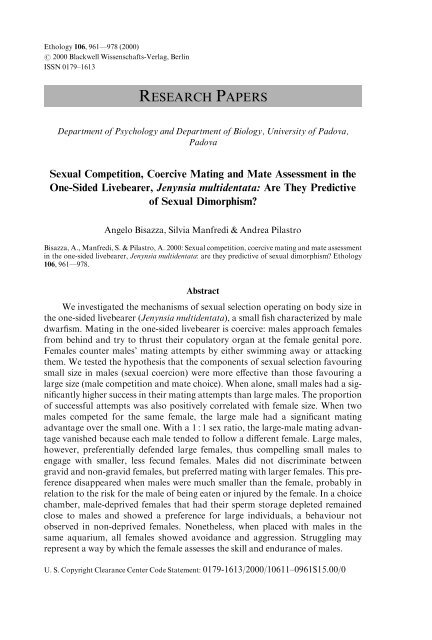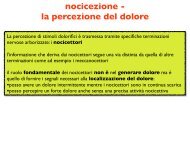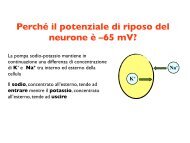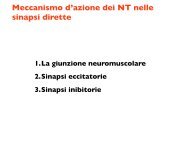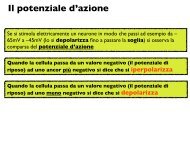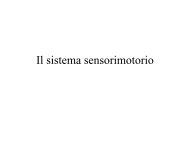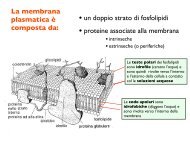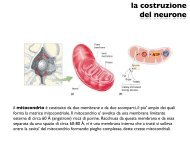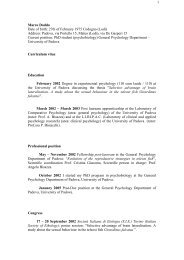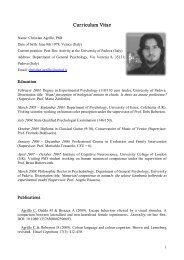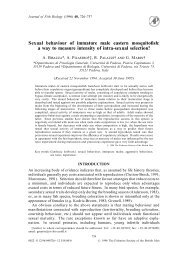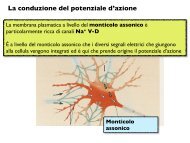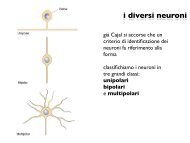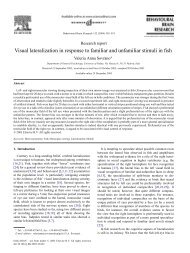Sexual Competition, Coercive Mating and Mate Assessment ... - CPRG
Sexual Competition, Coercive Mating and Mate Assessment ... - CPRG
Sexual Competition, Coercive Mating and Mate Assessment ... - CPRG
Create successful ePaper yourself
Turn your PDF publications into a flip-book with our unique Google optimized e-Paper software.
Ethology 106, 961Ð978 (2000)# 2000 Blackwell Wissenschafts-Verlag, BerlinISSN 0179±1613RESEARCH PAPERSDepartment of Psychology <strong>and</strong> Department of Biology, University of Padova,Padova<strong>Sexual</strong> <strong>Competition</strong>, <strong>Coercive</strong> <strong>Mating</strong> <strong>and</strong> <strong>Mate</strong> <strong>Assessment</strong> in theOne-Sided Livebearer, Jenynsia multidentata: Are They Predictiveof <strong>Sexual</strong> Dimorphism?Angelo Bisazza, Silvia Manfredi & Andrea PilastroBisazza, A., Manfredi, S. & Pilastro, A. 2000: <strong>Sexual</strong> competition, coercive mating <strong>and</strong> mate assessmentin the one-sided livebearer, Jenynsia multidentata: are they predictive of sexual dimorphism? Ethology106, 961Ð978.AbstractWe investigated the mechanisms of sexual selection operating on body size inthe one-sided livebearer (Jenynsia multidentata), a small ®sh characterized by maledwar®sm. <strong>Mating</strong> in the one-sided livebearer is coercive: males approach femalesfrom behind <strong>and</strong> try to thrust their copulatory organ at the female genital pore.Females counter males' mating attempts by either swimming away or attackingthem. We tested the hypothesis that the components of sexual selection favouringsmall size in males (sexual coercion) were more e€ective than those favouring alarge size (male competition <strong>and</strong> mate choice). When alone, small males had a signi®cantlyhigher success in their mating attempts than large males. The proportionof successful attempts was also positively correlated with female size. When twomales competed for the same female, the large male had a signi®cant matingadvantage over the small one. With a 1 : 1 sex ratio, the large-male mating advantagevanished because each male tended to follow a di€erent female. Large males,however, preferentially defended large females, thus compelling small males toengage with smaller, less fecund females. Males did not discriminate betweengravid <strong>and</strong> non-gravid females, but preferred mating with larger females. This preferencedisappeared when males were much smaller than the female, probably inrelation to the risk for the male of being eaten or injured by the female. In a choicechamber, male-deprived females that had their sperm storage depleted remainedclose to males <strong>and</strong> showed a preference for large individuals, a behaviour notobserved in non-deprived females. Nonetheless, when placed with males in thesame aquarium, all females showed avoidance <strong>and</strong> aggression. Struggling mayrepresent a way by which the female assesses the skill <strong>and</strong> endurance of males.U. S. Copyright Clearance Center Code Statement: 0179-1613/2000/10611±0961$15.00/0
962 A. Bisazza, S. Manfredi & A. PilastroCorresponding author: A. Pilastro, Dipartimento di Biologia, UniversitaÁ diPadova, via U. Bassi 38/B, I-35131 Padova, Italy. E-mail: pilastro@civ.bio.unipd.itIntroduction<strong>Sexual</strong> coercion is one of the potential outcomes of the con¯icts betweenmales <strong>and</strong> females that arise in sexual selection. In some animal species thismechanism can be as important as mate choice or male competition in determiningreproductive success in the two sexes (Berry & Shine 1980; Thornhill & Alcock1983; Westneat et al. 1990; Smuts & Smuts 1993). Interest in the costs borne byfemales <strong>and</strong> in strategies adopted to counteract male coercion is growing (Magurran& Nowak 1991; Clutton-Brock & Parker 1995).Clutton-Brock & Parker (1995) recognized three main forms of sexual coercion.A male can use its physical strength either to force copulation, to harass thefemale until she mates or to intimidate the female that refuses to mate. Greater size<strong>and</strong> physical strength is not essential for mating with unwilling females. In birds,males can unite to overcome female resistance (Castro et al. 1996). In ®shes withexternal fertilization, males can employ inconspicuousness or female mimicry toapproach mating pairs <strong>and</strong> release their sperm at the time of spawning (Gross1984; Taborsky 1994).Atherinomorphs are a relatively small group of ®shes inhabiting a great varietyof marine inshore, brackish <strong>and</strong> freshwater habitats. They are mostly egg-laying,but internal fertilization evolved independently in at least nine instances, <strong>and</strong>four families consist almost entirely of livebearers (Parenti 1981; Nelson 1994).Given the great number of di€erent reproductive adaptations shown by ®shes ofthis group, they provide a unique opportunity to study the relation between fertilizationmode <strong>and</strong> sexual selection mechanisms.<strong>Coercive</strong> mating appeared in at least four of the nine groups with internal fertilization.In the Phallostetidae (order Atheriniformes), males clasp females <strong>and</strong>physically force them to mate (Breder & Rosen 1966; Mok-Eym 1997). Conversely,in the Poeciliidae <strong>and</strong> Anablepidae (order Cyprinodontiformes) <strong>and</strong> in Horaichthyssetnai (order Beloniformes) males evolved a totally di€erent way ofobtaining copulations, by-passing female consent (Kulkarni 1940; Farr 1989). Themale approaches a female, usually from behind, <strong>and</strong> tries to thrust its copulatoryorgan into the female's gonoduct or to attach sperm near her genital pore, a tacticcommonly called gonopodial thrusting. In poeciliid ®shes using this tactic, bodysize is negatively correlated with mating success (Bisazza & Marin 1995; Bisazza &Pilastro 1997; Pilastro & Bisazza 1999). Small males appear to be favoured bothbecause they are less conspicuous <strong>and</strong> because they manoeuvre better when tryingto insert the gonopodium into the female's genital tract (Pilastro et al. 1997).Within this ®sh family, males court females <strong>and</strong> obtain copulations with their consent,or adopt gonopodial thrusting in case of female unwillingness. In some poeciliids,coercive copulation (gonopodial thrusting) is the only mating tactic adopted
<strong>Sexual</strong> Selection <strong>and</strong> Size Dimorphism in the One-Sided Livebearer963by males, whereas in other species both tactics (courtship <strong>and</strong> gonopodial thrusting)can be adopted (reviewed in Bisazza 1993).It was suggested (Farr 1989; Bisazza 1993) that interspeci®c variation in bothmale sexual ornamentation <strong>and</strong> body size is the consequence of the di€erentweight of various components of sexual selection in di€erent species. Gonopodialthrusting requires agility <strong>and</strong> inconspicuousness <strong>and</strong> therefore favours maledwar®sm <strong>and</strong> drabness. On the other h<strong>and</strong>, both an active role of the femalethrough mate selection <strong>and</strong> a strong in¯uence of male competition on mating successgenerally favour larger, ornamented males (Farr 1989). Male mate preferencescould also a€ect sexual selection <strong>and</strong> hence dimorphism. A special preference forparticular females, for example females which are close to fertilize a new batch ofeggs, may lead to an extremely male-biased operational sex ratio with consequentintensi®cation of both male competition <strong>and</strong> intrasexual selection (Bisazza &Marin 1995; Bisazza et al. 1996). A preliminary test of these hypotheses by comparisonof data available in the literature, suggested that among poeciliids, therelative size of males <strong>and</strong> their degree of ornamentation correlated signi®cantly<strong>and</strong> positively with the relative importance of female mate choice <strong>and</strong> male competition,<strong>and</strong> drabness <strong>and</strong> dwar®sm were signi®cantly associated with a predominantrole of sexual coercion (Bisazza 1993). The conclusions of this comparativeanalysis remain tentative since it was based on a limited number of species <strong>and</strong>used anecdotal data to a large extent. Further tests of this hypothesis require thestudy of sexual selection mechanisms in other ®shes with internal fertilization <strong>and</strong>a similar insemination mechanism.An opportunity for such a test is represented by ®shes of the family Anablepidae.The family is represented by two genera of livebearers, Jenynsia <strong>and</strong> Anableps,<strong>and</strong> by one egg-laying species, Oxyzygonectes dovii. Anablepidae are closelyrelated to Poeciliidae but they evolved internal fertilization <strong>and</strong> viviparity independently,from substrate-spawning ancestors (Parenti 1981; Novarini 1994). Sexesare monomorphic in coloration, but di€er in body size. In the one-sided livebearerJenynsia multidentata, in particular, males are much smaller than females, <strong>and</strong> thisspecies shows probably the most extreme example of size dimorphism in the atherinomorph®shes (Meyer et al. 1985; Ghedotti & Weitzman 1996). <strong>Sexual</strong> selection<strong>and</strong> mating ecology has never been investigated in this ®sh family, <strong>and</strong> only a fewaccounts of mating behaviour exist for these ®shes (Mattig & Greven 1994). <strong>Mating</strong>in the one-sided livebearer is coercive: males approach females from behind<strong>and</strong> try to thrust their copulatory organ at the female genital pore. Females countermales' mating attempts by either swimming away or attacking them. Courtshipdisplay was never observed in this species (Bisazza, unpubl. obs.).We studied the mechanisms of sexual selection in J. multidentata, in order tounderst<strong>and</strong> the occurrence of male dwar®sm <strong>and</strong> lack of male sexual ornaments inthis species. Studies on the closely related poeciliids showed that small males are atan advantage in coercive mating, whereas female choice <strong>and</strong> male±male competitiongenerally favour large males (Hughes 1985; Bisazza et al. 1996; Bisazza &Pilastro 1997; Ptacek & Travis 1997; Pilastro et al. 1997). Bisazza (1993, 1997) hasproposed that variation in sexual dimorphism within Atherinomorphs is mainly
<strong>Sexual</strong> Selection <strong>and</strong> Size Dimorphism in the One-Sided Livebearer965Fish used in the experiments were sexually mature <strong>and</strong> aged 6±12 months. Mosttests were carried out in small aquaria (60 36 cm) ®lled with water up to 30 cm<strong>and</strong> ®tted with rocks <strong>and</strong> plants on the bottom <strong>and</strong> abundant ¯oating vegetation.The experiment on male±male competition was performed in aquaria of larger size(69 69 cm). At the end of each test, males <strong>and</strong> females were anaesthetized withMS222 <strong>and</strong> st<strong>and</strong>ard length was taken to the nearest 0.5 mm.If not otherwise stated, means ‹ SD are given. Data were checked for normality<strong>and</strong>, when two or more groups were compared, for equality of variances.When these assumptions were not met, correspondent non-parametric tests wereused. All probabilities are two-tailed. Data were analysed with the SPSS statisticalpackage.Body Size <strong>and</strong> Success of <strong>Coercive</strong> Copulation through Gonopodial ThrustingIn this experiment we measured the success of coercive mating attempts inrelation to the length of the male <strong>and</strong> the female. A female was introduced into theexperimental aquarium <strong>and</strong> allowed to settle for 2 d. In the evening of the daybefore the beginning of the experiment, one male was also introduced <strong>and</strong> allowedto settle overnight. Observations were carried out the following morning (09:00 to13:00 h). For each replicate, male <strong>and</strong> female behaviour was observed for four periodsof 15 min, each separated by at least 30 min. In a few cases, one to three additional15-min observations were made until a minimum of 40 attempts per malehad been recorded.As an estimate of mating success, we counted the number of mating attemptsending with contact between genitalia. In studies with poeciliids (Hughes 1985;Yan 1987) this criterion has been used often as an estimate of a successful copulation,<strong>and</strong> the reliability of this method to estimate sperm transfer was recentlydemonstrated for the eastern mosquito®sh Gambusia holbrooki (Giacomello 1995;Pilastro et al. 1997). We calculated mating success as the proportion of contactsover the total number of coercive copulations (gonopodial thrusts) attempted.In one trial a male of 18 mm housed with a female of 67 mm disappeared duringthe night <strong>and</strong>, the day after, the female clearly showed a swollen belly. A similarevent was recorded during preliminary experiments, indicating that largefemales can eat small males if con®ned in a small aquarium. In the remaining tests,males of 19 mm or smaller were therefore not used. Male <strong>and</strong> female st<strong>and</strong>ardlength averaged 26.6 ‹ 4.6 mm (range 19.5±32 mm) <strong>and</strong> 43.8 ‹ 12.1 mm (range31±67 mm), respectively.Male±Male <strong>Competition</strong>Two males were allowed to compete for one (n ˆ 19) or two females (n ˆ 14)in a large aquarium (69 69 cm). Females were introduced into the aquarium 2 dbefore the beginning of the experiment, <strong>and</strong> two males were introduced the eveningbefore the test day. The two males di€ered in size, the smaller male beingaround 80% the st<strong>and</strong>ard length of the larger one (one-female trials: 81.6 ‹ 7.4%,range 64±90%; two-females trials: 75.7 ‹ 6.4%, range 62.5±86%). During the fol-
966 A. Bisazza, S. Manfredi & A. Pilastrolowing morning (09:00 to 12:00 h), the number of attacks <strong>and</strong> the number of matingattempts performed by each male was recorded during three 10-min periodsseparated by at least 15 min. The bottom of the aquarium was divided into a 23 23 cm grid made with thin blue plastic sticks. During tests with two females, theposition of the females was recorded using the grid as a reference in order to measurethe shoaling tendency of females. Females used in these trials di€ered in size,the st<strong>and</strong>ard length of the smaller being on average 79.8 ‹ 0.08% of the largerone.Females Choosing between Males of Di€erent LengthIn this experiment we used females that had been deprived of males for 60 d(st<strong>and</strong>ard length ˆ 42.1 mm ‹ 6.4, n ˆ 18) <strong>and</strong> females kept with males for thesame period (st<strong>and</strong>ard length ˆ 44.4 mm ‹ 7.2, n ˆ 16). Each test aquarium wasdivided length-wise into two unequal halves with a transparent glass divider. Thesmaller half was further subdivided into two compartments by a 12 8 cm ®lterplaced in the middle (Fig. 1). A ¯uorescent lamp was set over the two male compartments,whereas a black screen prevented the female compartment from beingilluminated directly. Thus, males were in full light <strong>and</strong> the female remained in theshade.One male was introduced into each of the two small compartments <strong>and</strong>allowed to settle for 24 h before the test. A single female was then placed in the centreof the female compartment <strong>and</strong> observations started as soon as the femaleresumed normal swimming. The test lasted for 30 min. At 30-s intervals the positionof the female was recorded. In particular, we recorded: (i) which of the twohalves of the compartment, in relation to the males' compartment, the female wasoccupying; (ii) whether the female was closer or further than one body length fromFig. 1: Apparatus used for female choice test (M ˆ male compartment, FE ˆ female compartment,FI ˆ ®lter)
<strong>Sexual</strong> Selection <strong>and</strong> Size Dimorphism in the One-Sided Livebearer967the glass dividing her compartment from that of the male; <strong>and</strong> (iii) the number ofobserved attempts to enter one or the other male's compartment. The sizes of thelarge <strong>and</strong> small males in the two experiments averaged 29.9 mm ‹ 2.5 st<strong>and</strong>ardlength <strong>and</strong> 20.2 mm ‹ 1.6 st<strong>and</strong>ard length (male-deprived females), <strong>and</strong> 28.5 mm‹ 1.8 st<strong>and</strong>ard length <strong>and</strong> 19.8 mm ‹ 2.3 st<strong>and</strong>ard length (females kept withmales), respectively.Male Choosing between Gravid <strong>and</strong> Non-Gravid FemalesThis experiment was aimed at testing whether males of J. multidentata showany preference for male-deprived, virgin or postpartum females over gravidfemales previously kept with males.Male-deprived femalesTen females were deprived of males for 80 days. During the last 30 days,females were kept under observation to ensure that none was pregnant. Eachdeprived female was then paired with a gravid female (distinguishable because ofher more prominent belly) of similar size (‹ 5% st<strong>and</strong>ard length), but which hadbeen previously maintained with males. The two females were introduced into oneexperimental aquarium <strong>and</strong> allowed to settle for 2 d. One male, previouslydeprived of females for 24 h, was then introduced into the aquarium. Male matingattempts were scored for 60 min starting from the ®rst attempt (usually within 20 safter the male was introduced). Sometimes females reacted to male attempts byattacking or chasing the male. The number of aggressive acts by the femalestowards the male was also scored.Virgin femalesThe previous experiment was repeated with the same set-up but using 10 virginfemales instead of male-deprived ones.Post-partum femalesThe preference of males for postpartum females was tested with a slightly differentset-up. Females which are close to parturition are distinguishable from theother gravid females because of their particularly prominent belly. We used sixdyads of females composed of one female close to the parturition paired with asimilar-sized female which was gravid but not close to parturition. For each testday, a di€erent male r<strong>and</strong>omly taken from a stock of 30 males, was introducedinto the aquarium containing the two females. On each day until 6 d after parturitionwe scored the number of male mating attempts <strong>and</strong> female aggressive actstowards the male for 60 min after the ®rst male's attempt. We considered in theanalyses the observations carried out on the nine consecutive days, starting 2 dbefore <strong>and</strong> ending 6 d after parturition. At the end of the test, the male wasreleased back into the stock aquarium, <strong>and</strong> he might therefore have been usedmore than once.
968 A. Bisazza, S. Manfredi & A. PilastroMales Choosing between Females of Di€erent LengthTwo gravid females of di€erent sizes were introduced into the experimentalaquarium <strong>and</strong> allowed to settle for 2 d. Large females averaged 53.6 ‹ 8.7 mmst<strong>and</strong>ard length (range 41±67 mm); small females averaged 36.4 ‹ 5.8 mm st<strong>and</strong>ardlength (range 30±46 mm). On average, the st<strong>and</strong>ard length of the small femalewas 68.3 ‹ 6.6% of the large one. One male, previously deprived of females for 48h, was then introduced into the aquarium <strong>and</strong> the number of his mating attemptswith the two females was counted for 30 min after the ®rst attempt; 20 replicateswere made. The average st<strong>and</strong>ard length of males was 25.2 ‹ 3.7 mm (range 21±33 mm).Six additional very small males (mean st<strong>and</strong>ard length ˆ 21.4 ‹ 0.92 mm;range 20±22.5 mm) were tested using pairs of females that were smaller than thoseof the previous tests. In these replicates, large <strong>and</strong> small females averaged 33.3 ‹2.4 mm (range 30±37.5 mm) <strong>and</strong> 25.8 ‹ 1.9 mm (range 23.5±28.5 mm), respectively.In this case, the average st<strong>and</strong>ard length of the small female was 77.6 ‹4.4% of that of the large one.ResultsBody Size <strong>and</strong> Success of <strong>Coercive</strong> Copulation through Gonopodial ThrustingThe sexual behaviour of males is stereotyped <strong>and</strong> consists exclusively of coercivecopulatory attempts through gonopodial thrusting. When a male meets afemale, he moves immediately behind her <strong>and</strong> then darts forward along the side ofthe female corresponding to the side he is able to bring forward his gonopodium.When his snout is at the level of the female's tail, he rotates the gonopodium forward<strong>and</strong>, keeping his body in close contact with that of the female, tries repeatedlyto insert his gonopodium into her gonopore. Females usually swim away,trying to avoid copulation. Often, especially under intense harassment, femalesreact by turning <strong>and</strong> attacking the male.The e€ect of male <strong>and</strong> female length on the frequency of successful copulationattempts over the total attempts was tested using a multiple regression analysis.Both male size <strong>and</strong> female size were signi®cantly correlated with mating success,although the correlation with the latter was much higher (female size: partial r ˆ0.68, p
<strong>Sexual</strong> Selection <strong>and</strong> Size Dimorphism in the One-Sided Livebearer969Fig. 2: Relation between male relative length (male st<strong>and</strong>ard length/female st<strong>and</strong>ard length) <strong>and</strong> malemating success. <strong>Mating</strong> success was expressed as the frequency of copulatory attempts (gonopodialthrust) ending with a contact between genitalia, over the total number of attemptssame number of attacks as the larger one. The proportion of attacks carried out bythe large male was not correlated with the di€erence in length between the twomales (Pearson correlation coecient r ˆ 0.02, ns, n ˆ 19), nor with the size of thefemale (r ˆ 0.23, ns, n ˆ 19). Large males made signi®cantly more mating attemptsthan small ones (Table 1), but variance was large <strong>and</strong> in ®ve trials small malesshowed more attempts than large ones. Overall, the proportion of mating attempts<strong>and</strong> dominance, i.e. proportion of aggressive attacks, were positively correlatedwith each other (r ˆ 0.60, p ˆ0.006, n ˆ 19).Table 1: Number of male copulatory attempts <strong>and</strong> attacks towards the other male in relationto male length (mean ‹ SD) <strong>and</strong> sex ratio. For behavioural data, median <strong>and</strong> interquartilerange are givenSex ratioNo. of attacksNo. of copulatoryattempts2 males, 1 female (n ˆ 19)Larger male (SL) (28.2 mm ‹ 2.3)Smaller male (SL) (23.0 mm ‹ 2.4)Wilcoxon signed-ranks test2 males, 2 females (n ˆ 14)Larger male (SL) (28.3 mm ‹ 3.1)Smaller male (SL) (21.3 mm ‹ 1.8)17 (6±25)1 (0±4)z ˆ 2.98, p ˆ0.00242 (23±52)15 (9±21)z ˆ 3.83, p
970 A. Bisazza, S. Manfredi & A. PilastroIn the replicates with two females, females showed little tendency to shoal <strong>and</strong>during 79.1 ‹ 7.8% (range 70±93.3%) of the observation periods they were swimmingin two di€erent squares of the grid <strong>and</strong> were usually followed by one male ata time. Fights between males occurred almost exclusively when both males werefollowing the same female. Large males still made signi®cantly more attacks thansmall ones (Table 1). There was a tendency for reduced aggressiveness of the smallmales in trials with two females but the di€erence was non-signi®cant (z ˆ 1.48, pˆ0.15, n ˆ 14, Mann±Whitney test). With a 1 : 1 sex ratio, the number of matingattempts carried out by the small male was nearly identical to that performed bythe large male (Table 1). The proportion of mating attempts carried out by thelarge male in these replicates was signi®cantly lower than that observed in thereplicates with two males <strong>and</strong> one female (t ˆ 3.76, p ˆ0.001, n ˆ 33). Large malesdid most of their mating attempts with the large female, whereas small males didmost of their mating attempts with the small female (repeated measure ANOVA, Fˆ 58.3, df ˆ 3,39, p
<strong>Sexual</strong> Selection <strong>and</strong> Size Dimorphism in the One-Sided Livebearer971Fig. 4: Females choosing between males of di€erent size. Number of times which females wereobserved, respectively, far, close (i.e. within one body length) <strong>and</strong> attempting to enter the compartmentof the large male (shaded box) <strong>and</strong> small male (open box). Results for male-deprived (n ˆ 18) <strong>and</strong> nondeprivedfemales (n ˆ 16) are shown (D ˆ male-deprived; ND ˆ non-deprived). An asterisk indicates asigni®cant preference (p 0.05,n ˆ 16).Males Choosing between Gravid <strong>and</strong> Non-Gravid FemalesMale-deprived femalesMales did not show any preference for gravid or deprived females, as thenumber of mating attempts directed towards females did not di€er between thetwo groups (z ˆ 0.53, p ˆ0.63, Wilcoxon signed-ranks test, Table 2). Deprivedfemales were less aggressive towards males than gravid females, although not signi®cantlyso (z ˆ 1.56, p ˆ0.16, n ˆ 10, Wilcoxon signed-ranks test).Virgin femalesThe number of male mating attempts towards virgin females did not di€erfrom that towards gravid females (z ˆ 0.36, p ˆ0.75, n ˆ 10, Wilcoxon signedrankstest, Table 2). Virgin females were less aggressive than gravid ones, althoughnot signi®cantly so (z ˆ 1.25, p ˆ0.24, n ˆ 10, Wilcoxon signed-ranks test). Onemale in this experiment made an exceptionally high number of attempts (308) <strong>and</strong>received a proportionally high number of attacks from females (109). Conclusionsdid not change after removal of this outlier.
972 A. Bisazza, S. Manfredi & A. PilastroTable 2: St<strong>and</strong>ard length (mean ‹ SD), number of male copulatory attempts, <strong>and</strong> attacksby the female in relation to the female's reproductive condition. For behavioural data, median<strong>and</strong> interquartile range are givenExperiment n Female SL (mm)No. ofcopulatoryattemptsNo. ofattackstowardsmaleMale-deprived 10 Male-deprived 44.0 ‹ 5.1 52 (46.5±70.3) 2 (0±3.75)Gravid 44.5 ‹ 4.5 52.5 (47.5±66.5) 4.5 (1.75±6.0)Virgin 10 Virgin 41.7 ‹ 2.8 59 (51±64) 4 (1±15.5)Gravid 40.5 ‹ 7.1 43.5 (35±88.8) 16.5 (2.5±34)Post-partum 6 Post-partum a 49.2 ‹ 7.7 27 (21.5±33.5) 6.5 (0±9.75)Gravid 49.6 ‹ 7.4 56 (43.8±58.5) 1.75 (0.38±6.13)a Average of the ®rst 2 d after parturition. SL, st<strong>and</strong>ard length.The proportion of male mating attempts towards gravid females was notlower than that towards virgin <strong>and</strong> deprived females even when the latter werepooled (z ˆ 0.12, p ˆ0.91, n ˆ 20, Wilcoxon signed-ranks test). Males did notshow any mate preference even if only the ®rst 30 or 10 min of observation wereconsidered (z ˆ 0.36, p ˆ0.52; z ˆ 0.02, p ˆ0.99, respectively, Wilcoxon signedrankstest). When data of virgin <strong>and</strong> deprived females were pooled, non-gravidfemales were signi®cantly less aggressive than gravid females (z ˆ 1.92, p ˆ0.05, nˆ 20, Wilcoxon signed-ranks test). The proportion of attacks performed by thetwo types of females was not signi®cantly correlated with the proportion of malemating attempts received (r ˆ 0.18, n ˆ 20, ns).Post-partum femalesThe results of this experiment showed that females close to parturition werepreferred over normal gravid females, whereas the latter were preferred to thosefemales that had recently delivered young. Two days after parturition any preferencedisappeared <strong>and</strong> male mating attempts towards postpartum females becameagain close to 50% (Fig. 5). The frequency of male mating attempts towards postpartumfemales di€ered signi®cantly between days (w 2 ˆ 22.4, df ˆ 8, p
<strong>Sexual</strong> Selection <strong>and</strong> Size Dimorphism in the One-Sided Livebearer973Fig. 5: Males choosing between gravid <strong>and</strong> postpartum females: Proportion of the copulatory attempts(% with SD bars) made by males towards the postpartum female in relation to the gravid female,against the female's reproductive cycle (0 ˆ d of parturition; n ˆ 6). Hatched bars indicate a proportionsigni®cantly di€erent from 50% (p
974 A. Bisazza, S. Manfredi & A. PilastroTable 3: Male choosing between two females of di€erent length: mean ‹SD number ofmale copulatory attempts in relation to male <strong>and</strong> female st<strong>and</strong>ard lengthFrequency ofcopulatoryCopulatory attemptsattempts withthe large femalen Larger female Smaller female (%)Larger female >40 mmLarge males (24±33 mm) 11 43.3 ‹ 34.6 15.1 ‹ 3.9 75.1 ‹ 17.9 aSmall males (< 23 mm) 9 17.1 ‹ 9.6 31.7 ‹ 9.5 34.5 ‹ 14.8 bLarger female
<strong>Sexual</strong> Selection <strong>and</strong> Size Dimorphism in the One-Sided Livebearer975or virgin females from gravid females. In summary, we found that the e€ects ofmale body size on sexual selection mechanisms were similar to those found in theeastern mosquito®sh, which shows an analogous mating system dominated by sexualcoercion (Bisazza & Marin 1991, 1995).In particular, the e€ect of male <strong>and</strong> female body size on the success of gonopodialthrusting in the one-sided livebearer appears to be the same as that found inG. holbrooki (Bisazza & Marin 1995; Pilastro et al. 1997) <strong>and</strong> in four other poeciliidspecies (Bisazza & Pilastro 1997; Pilastro & Bisazza 1999): the frequency of successfulmating attempts was positively correlated with female size <strong>and</strong> negativelywith male size. The reasons for the latter correlation are probably the same as forpoeciliids, i.e. a greater manoeuvrability <strong>and</strong> inconspicuousness of small males(Pilastro et al. 1997).When two males with di€erent size were experimentally forced to compete forthe same female, the large male did a larger part of mating attempts, although hewas not able to prevent the small male from doing a notable proportion of matingattempts. With a sex ratio of 1 : 1, competition for females was reduced <strong>and</strong> smallmales had the same opportunity as larger males to attempt copulations. Amongpoeciliids, females tend to shoal <strong>and</strong> a dominant male may be equally able tomonopolize one or many females (Bisazza & Marin 1995). Both ®eld observations(Bleher, pers. comm.) <strong>and</strong> the results of competition experiments in the presentstudy indicate that female one-sided livebearers forage individually <strong>and</strong> have ascarce tendency to aggregate, which may be responsible for the inability of malesto monopolize more than one mate at time. From these results we expect that largemales will be at a competitive advantage only at high population densities or withhighly male-biased sex ratios.We did not expect to ®nd female mate choice since female J. multidentatanever overtly co-operate with males to achieve copulation. However, evidence hasbeen recently found that eastern mosquito®sh females deprived of males for sometime tend to approach males, thus increasing the probability of being inseminated(Pilastro et al. 1997; Bisazza et al. 2000). These results provide interesting newhints concerning the sexual dynamics generated by the evolution of coercive mating.In fact, one-sided livebearer females showed apparently inconsistent behaviour:in the female mate-choice experiment they actively sought (large) malevicinity, but when in the same aquarium with males (in male choice experiments),they showed avoidance <strong>and</strong> aggression towards males. One possible explanation isthat if multiple matings are costly to females (Magurran & Seghers 1994), theymay tolerate association with a male if he repels copulatory attempts by othermales (Arnqvist 1989). In the Italian populations of G. holbrooki, for example,females never obviously co-operate with males during matings, but they activelyseek the proximity with the largest, dominant male in their group. The dominantmale interferes with the sexual activity of subordinates, reducing it to less than10%. By doing this he also reduces the time available for his own sexual activity.Thus, females are less harassed by a group of males than by a single male (Bisazza& Marin 1995). The above interpretation is consistent with the traditional viewabout species with male coercive mating tactics. Female struggling is viewed as the
976 A. Bisazza, S. Manfredi & A. Pilastromanifestation of an asymmetry in mating interests. Males try to obtain as manymatings as possible, whereas females attempt to avoid or reduce costs associatedwith multiple <strong>and</strong> indiscriminate mating (Clutton-Brock & Parker 1995 <strong>and</strong> referencestherein). Conversely, in some cases, females may resist male attempts inorder to select mates showing strength <strong>and</strong> endurance (Thornhill 1980; Arnqvist1992; Allen & Simmons 1996). Under this view, female J. multidentata's reluctanceto copulate may be a way to select males in perfect physical conditions, able toinseminate unwilling females.Males apparently did not discriminate females according to the phase of theirreproductive cycle. However, these experiments were based on small sample sizes<strong>and</strong> would need to be con®rmed by a larger data set. Conversely, males made signi®cantlymore mating attempts with larger, more fecund, females. Interestingly,we found that in small males, mate preference could be reversed if they were confrontedwith very large females. Anecdotal evidence (see Methods) suggests thatlarge females can prey on small males. The same phenomenon was observed in G.holbrooki, <strong>and</strong> it was suggested that this may set a lower limit to selection for smallsize of males (Bisazza 1993).Other possible selective factors determining the observed reversed sexual sizedimorphism, other than a small male advantage in coercive mating, should be considered.Possible alternatives include the fecundity advantage of large females(Ralls 1976), the advantage of an early maturation in males (Bisazza 1993), areduced growth rate of males as a consequence of the intense sexual activity, <strong>and</strong>an energetic advantage of small males in locomotion (Blanckenhorn et al. 1995).As suggested by Clutton-Brock & Parker (1995), large size in females may also befavoured because it reduces sexual harassment by males. These alternative hypothesesare not mutually exclusive.In conclusion, the results of this study suggest that coercive mating may havean important role in sexual selection mechanisms in ®shes with internal fertilization,<strong>and</strong> may be responsible for reverse sexual size dimorphism. This mating tactichas been traditionally considered an alternative tactic adopted by competitivelyinferior males, doing the best of a bad job. However, our results suggest that this isnot necessarily so, <strong>and</strong> that, most importantly, the female's role is not a passiveone. Con¯ict between the two sexes can give rise to an intricate set of di€erent sexualselection mechanisms (Henson & Warner 1997), whose outcome, in terms ofsexual dimorphism, are not easily predictable.AcknowledgementsWe would like to thank George Barlow, Guglielmo Marin, Giuliano <strong>Mate</strong>ssi, Michael Taborsky<strong>and</strong> two anonymous referees for their comments on various versions the manuscript. This study waspartially supported by a 60% grant from the Ministero per l'Universita 0 e la Ricerca Scienti®ca e Tecnologicato A. B.Literature CitedAllen, G. R. & Simmons, L. W. 1996: <strong>Coercive</strong> mating, ¯uctuating asymmetry, <strong>and</strong> male mating successin the dung ¯y Sepsis cynipsea. Anim. Behav. 52, 737Ð741.
<strong>Sexual</strong> Selection <strong>and</strong> Size Dimorphism in the One-Sided Livebearer977Andersson, M. 1994: <strong>Sexual</strong> Selection. Princeton Univ. Press, Princeton, New Jersey.Arnqvist, G. 1989: Multiple mating in a water strider: mutual bene®t or intersexual con¯ict? Anim.Behav. 38, 749Ð756.Arnqvist, G. 1992: Pre-copulatory ®ghting in a water strider: inter-sexual con¯ict or mate assessment?Anim. Behav. 43, 559Ð567.Berry, J. F. & Shine, R. 1980: <strong>Sexual</strong> dimorphism <strong>and</strong> sexual selection in turtles (order Testudines).Oecologia 44, 185Ð191.Bisazza, A. 1993: Male competition, female mate choice <strong>and</strong> sexual size dimorphism in poeciliid ®shes.In: Behavioural Ecology of Fishes (Huntingford, F. A. & Torricelli, P., eds). Harwood AcademicPress, Chur, Switzerl<strong>and</strong>, pp. 257Ð286.Bisazza, A. 1997: <strong>Sexual</strong> selection constrained by internal fertilization in the livebearing ®sh Xenotocaeiseni. Anim. Behav. 54, 1347Ð1355.Bisazza, A., Marconato, A. & Marin, G. 1989: Male mate preference in the mosquito®sh Gambusia holbrooki.Ethology 83, 335Ð343.Bisazza, A. & Marin, G. 1991: Male size <strong>and</strong> female mate choice in the eastern mosquito®sh. Copeia1991, 730Ð735.Bisazza, A. & Marin, G. 1995: <strong>Sexual</strong> selection <strong>and</strong> sexual size dimorphism in the eastern mosquito®shGambusia holbrooki (Pisces Poeciliidae). Ethol. Ecol. Evol. 7, 169Ð183.Bisazza, A., Novarini, N. & Pilastro, A. 1996: Male body size <strong>and</strong> male±male competition: Interspeci®cvariation in poeciliid ®shes. Ital. J. Zool. 63, 365Ð369.Bisazza, A. & Pilastro, A. 1997: Small male mating advantage <strong>and</strong> reversed size dimorphism in poeciliid®shes. J. Fish. Biol. 50, 397Ð406.Bisazza, A., Vaccari, G. & Pilastro, A. 2000: Female mate choice in a mating system dominated by malesexual coercion. Behav. Ecol., in press.Blanckenhorn, W. U., Preziosi, R. F. & Fairbairn, D. J. 1995: Time <strong>and</strong> energy constraints <strong>and</strong> the evolutionof sexual dimorphism ± to eat or to mate? Evol. Ecol. 9, 369Ð381.Breder, C. M. & Rosen, D. E. 1966: Modes of Reproduction in Fishes. Natural History Press, GardenCity, NY.Castro, I., Minot, E. O., Fordham, R. A. & Birkhead, T. R. 1996: Polygyn<strong>and</strong>ry, face-to-face copulation<strong>and</strong> sperm competition in the Hihi Notiomystis cincta (Aves: Meliphagidae). Ibis 138, 765Ð771.Clutton-Brock, T. H. & Parker, G. A. 1995: <strong>Sexual</strong> coercion in animal societies. Anim. Behav. 49,1345Ð1365.Constantz, G. D. 1984: Sperm competition in Poeciliid ®shes. In: Sperm <strong>Competition</strong> <strong>and</strong> the Evolutionof Animal <strong>Mating</strong> Systems (Smith, R. L., ed. ). Academic Press, Orl<strong>and</strong>o, pp. 465Ð485.Constantz, G. D. 1989: Reproductive biology of Poeciliid ®shes. In: Ecology <strong>and</strong> Evolution of LivebearingFishes (Poeciliidae) (Me€e, G. K. & Snelson, F. F., eds). Prentice Hall, Englewood Cli€s,pp. 33Ð50.Darwin, C. 1871: The Descent of Man <strong>and</strong> Selection in Relation to Sex, 2nd edn. Murray, London.Farr, J. A. 1989: <strong>Sexual</strong> selection <strong>and</strong> secondary di€erentiation in poeciliids: determinants of male matingsuccess <strong>and</strong> the evolution of female choice. In: Ecology <strong>and</strong> Evolution of Livebearing Fishes(Poeciliidae) (Me€e, G. K. & Snelson, F. F., eds). Prentice Hall, Englewood Cli€s, pp. 91Ð123.Ghedotti, M. J. & Weitzman, S. H. 1996: A new species of Jenynsia (Cyprinodontiformes: anablepidae)from Brazil with comments on the composition <strong>and</strong> taxonomy of the genus. Univ. Kansas. Nat.Hist. Mus. Occ. 179, 1Ð25.Giacomello, E. 1995: Dimor®smo maschile e successo riproduttivo in Gambusia holbrooki (Pisces, Poeciliidae).PhD Thesis, Univ. of Padova, Padova, Italy.Gross, M. R. 1984: Sun®sh, salmon <strong>and</strong> the evolution of alternative reproductive strategies <strong>and</strong> tacticsin ®shes. In: Fish Reproduction: Strategies <strong>and</strong> Tactics (Wootton, R. & Potts, G., eds). AcademicPress, London, pp. 55Ð75.Henson, S. A. & Warner, R. R. 1997: Male <strong>and</strong> female alternative reproductive behaviors in ®shes: anew approach using intersexual dynamics. Ann. Rev. Ecol. Syst. 28, 571Ð592.Hughes, A. L. 1985: Male size, mating success, <strong>and</strong> mating strategy in the mosquito®sh Gambusia anis(Poecilidae). Behav. Ecol. Sociobiol. 17, 271Ð278.
978 A. Bisazza, S. Manfredi & A. PilastroKulkarni, C. V. 1940: On the systematic position, structural modi®cation, bionomics <strong>and</strong> developmentof a remarkable new family of cyprinodont ®shes from the province of Bombay. Rec. Indian. Mus.42, 379Ð423.Magurran, A. E. & Nowak, M. A. 1991: Another battle of the sexes: The consequences of sexual asymmetryin mating costs <strong>and</strong> predation risk in the guppy, Poecilia reticulata. Proc. R. Soc. Lond. B.246, 31Ð38.Magurran, A. E. & Seghers, B. H. 1994: <strong>Sexual</strong> con¯ict as a consequence of ecology: Evidence fromguppy, Poecilia reticulata, populations in Trinidad. Proc. R. Soc. Lond. B. 255, 31Ð36.Mattig, S. & Greven, H. 1994: Beobachtungen zur Balz und Paarung des Vieraugen®sches Anablepsanableps (Linne , 1758) (Anablepidae, Cyprinodontiformes). Z. Fischk. 2, 167Ð192.Meyer, M. K., Wischnath, L. & Foerster, W. 1985: LebendgebaÈ rende Zier®sche: Arten der Welt. Mergus-Verlag,Melle, Germany.Mok-Eym, & Munro, A. D. 1997: Some anatomical <strong>and</strong> behavioural aspects of reproduction in membersof an unusual teleost Family: the Phallostethidae. J. Nat. His. 31, 739Ð778.Nelson, J. S. 1994: Fishes of the World. Wiley, New York.Novarini, N. 1994: Filogenesi molecolare ed evoluzione della fecondazione interna e della viviparitaÁnegli Atherinomorpha. PhD Thesis, Univ. of Padova, Padova, Italy.Parenti, L. R. 1981: A phylogenetic <strong>and</strong> biogeographic analysis of cyprinodontiform ®shes (Teleostei,Atherinomorpha). Bull. Amer. Mus. Nat. His. 168, 335Ð557.Pilastro, A. & Bisazza, A. 1999: Insemination eciency of two alternative male mating tactics in theguppy (Poecilia reticulata). Proc. R. Soc. Lond. B. 266, 1867Ð1872.Pilastro, A., Giacomello, E. & Bisazza, A. 1997: <strong>Sexual</strong> selection for small size in male mosquito®sh(Gambusia holbrooki). Proc. R. Soc. Lond. B. 264, 1125Ð1129.Ptacek, M. B. & Travis, J. 1997: <strong>Mate</strong> choice in the sail®n molly, Poecilia latipinna. Evolution 51,1217Ð1231.Ralls, K. 1976: Mammals in which females are larger than males. Q. Rev. Biol. 51, 245Ð276.Smuts, B. B. & Smuts, R. W. 1993: Male aggression <strong>and</strong> sexual coercion of females in nonhuman primates<strong>and</strong> other mammals: evidences <strong>and</strong> theoretical implications. Adv. Study. Behav. 22, 1Ð63.Snelson, F. F. 1982: Indeterminate growth in males of the sail®n molly, Poecilia latipinna. Copeia 1982,296Ð304.Taborsky, M. 1994: Sneakers, satellites, <strong>and</strong> helpers: parasitic <strong>and</strong> cooperative behaviour in ®sh reproduction.Adv. Stud. Behav. 23, 1Ð100.Thornhill, R. 1980: Rape in Panorpa scorpion¯ies <strong>and</strong> a general rape hypothesis. Anim. Behav. 28,52Ð59.Thornhill, R. & Alcock, J. 1983: The Evolution of Insect <strong>Mating</strong> Systems. Harvard Univ. Press, Cambridge.Westneat, D. F., Sherman, P. W. & Morton, M. L. 1990: The ecology <strong>and</strong> evolution of extra-pair copulationsin birds. Curr. Ornithol. 7, 331Ð369.Yan, H. Y. 1987: Size at maturity in male Gambusia heterochir. J. Fish. Biol. 30, 731Ð741.Received: February 4, 1999Initial acceptance: June 11, 1999Final acceptance: January 24, 2000 (M. Taborsky)


